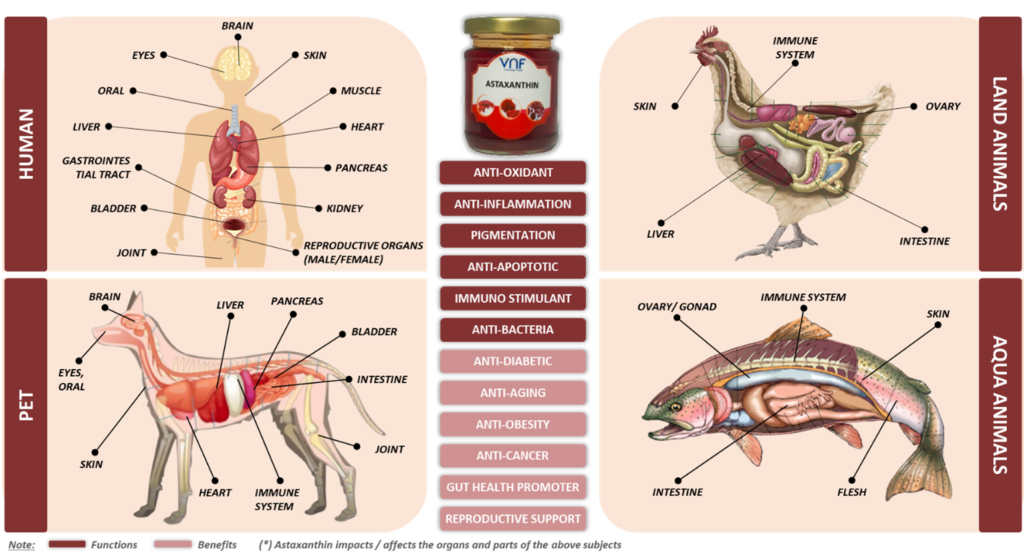As a big fan of VNF (we trust you are), you have probably become familiar with VNF’s Peptides and Chitosan retrieved from shrimp by-products. Yet, the same shrimp by-products (that you throw away) keep on astounding us with more potential extracted value and nutrients. This time, the “magical” superfood –“Astaxanthin” – also known as the “King of Antioxidants”! Hidden in various structures in different objects, Astaxanthin boasts a vibrant color with many superpowers!
To fully comprehend what superpowers exist in Astaxanthin, let’s dive into what it is, where it comes from and what it can be used for.
WHAT IS ASTAXANTHIN & WHERE DOES IT COME FROM?
Astaxanthin was first identified and isolated from lobster by Richard Kuhn in 1938. That same year, Kuhn was awarded a Nobel Prize in Chemistry for his work on carotenoids and vitamins [1].
Astaxanthin is a carotenoid of red pigment, naturally found in the skin, meat, fins, and shells of crustaceans, crabs, salmon and red microalgae, etc. However, the typical red color of Astaxanthin is sometimes “disguised” in blue, yellow or dark brown because Astaxanthin binds with a particular protein (for example, in shrimps) and can only be released when cooked.
Animals CAN NOT synthesize Astaxanthin de novo. Therefore, aquatic animals (shrimps and salmon) and humans have to acquire Astaxanthin from their diet. In nature, ONLY certain microalgae, yeast and bacteria can biosynthesize Astaxanthin [2]. Microalgae – the primary and most common source – once consumed, then transfer Astaxanthin to zooplankton, crustaceans and fish. This explains why farmed shrimp and salmon normally appear paler in meat/shell color compared with wild aquaculture. Farmers, therefore, must add red carotenoid pigments (such as Astaxanthin) to the feed to deliver more vibrantly colored shrimp and salmon.

WHERE DOES ASTAXANTHIN’S SUPERPOWER COME FROM?
Microalgae create Astaxanthin under unfavorable living conditions, such as lack of nutrients, increased salinity, or excessive sunshine. Thus, astaxanthin serves as the microalgae’s defense response against environmental stress to survive and grow – thereby demonstrating Astaxanthin’s inherently potent antioxidant activity, the same function that Astaxanthin is most famous for.
Astaxanthin’s superpower extends beyond being an Antioxidant. In fact, Astaxanthin is even considered a “Superfood”, capable of supporting almost all the functions of the living body (gastrointestinal tract, immune, circulatory, nervous and reproductive system, etc.) and organs (muscles, joints, skin and eyes, etc.). Astaxanthin also exerts anti-cancer effects!

Being multi-functional, Astaxanthin offers tremendous benefits for almost all living beings – from aquatic animals (fish, shrimp), land-based (swine, cow, chicken), pets (dogs, cats) and Humans. Natural Astaxanthin promises a massive breakthrough in preventative healthcare for all!
COMMON SOURCES OF ASTAXANTHIN & THEIR CONSTRAINTS
There are 2 common sources of Astaxanthin: Synthetic Astaxanthin (~90% market share in 2014) [3] and Natural Astaxanthin (mostly from microalgae).
Astaxanthin is not widely used despite proven effects, mainly due to limited supply (especially for Natural Astaxanthin, which requires sophisticated technology and production cost barriers). Therefore, unless we solve the cost issues, we are restricted from exploring Astaxanthin’s potentials and applications fully.

‘Shrimp-based Astaxanthin’ could be the key answer!
Using shrimp by-products with abundant and increasing supply, VNF’s proprietary technology (applying biotechnological zero-waste mindset) enables highly efficient and cost–competitive extraction of Natural Astaxanthin.
As one of the very few companies capable of mass-scale Shrimp-based Astaxanthin production, VNF aims to expand Astaxanthin supply and make it accessible for all industries. Starting first with Animals – inherently high demand but currently quite pricey – Astaxanthin can improve overall health, possibly reduce antibiotics use, improve welfare… thus increasing farming efficiency aligned to more natural and sustainable directions.
References:
[1] Award ceremony speech. NobelPrize.org. Nobel Prize Outreach AB 2021. https://www.nobelprize.org/prizes/chemistry/1938/ceremony-speech/ [assessed 12 Nov 2021]
[2] B. Capelli, D. Bagchi & G. Cysewski (2013), “Synthetic astaxanthin is significantly inferior to algal-based astaxanthin as an antioxidant and may not be suitable as a human nutraceutical supplement” Nutrafoods., doi: 12. 10.1007/s13749-013-0051-5.
[3] S. H. A. Raza et al., “Beneficial effects and health benefits of Astaxanthin molecules on animal production: A review,” Res. Vet. Sci., vol. 138, no. March, pp. 69–78, 2021, doi: 10.1016/j.rvsc.2021.05.023.











